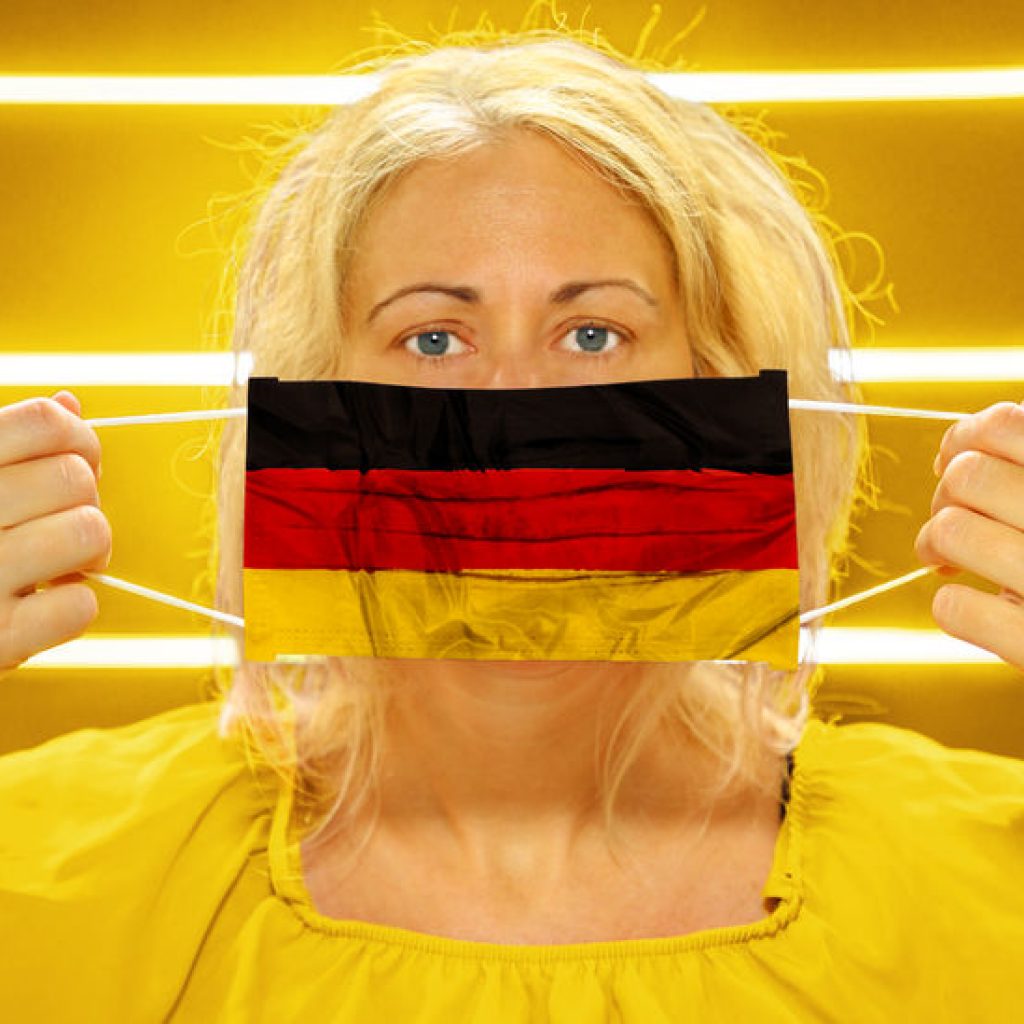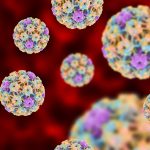KATHERINE WILLOW, ND
German New Medicine (GNM) is a series of interrelated discoveries made by the late German internist, Dr Ryke Geerd Hamer (1935-2017). Together, these discoveries create a radically new way of looking at the cause and progression of conditions that do not have an obvious external origin (such as poisoning, accidents, or nutritional deficiencies).
The basic premises of GNM are as follows:
- Most conditions are physical responses to biological shocks, in an attempt to help us survive.
- For each condition triggered by a shock, there are 2 phases, active and healing, with completely different symptoms in each phase.
Understanding the initiating shock and the phase in which a patient presents can lead to targeted corrective treatment and result in improved outcomes, even with difficult conditions.
The 5 Laws of GNM
Dr Hamer presented his findings in the form of 5 laws. In addition, he unraveled myriad related principles, many of which can be life-saving in the appropriate situation. This article summarizes these laws and demonstrates briefly how they have been successfully applied in 4 cases of cancer at our general-practice naturopathic clinic.
Law One
Law One states that most conditions are responses by the body to a biological shock and that they developed specifically to handle such disruptions.
Biological shocks are events that trigger our primitive survival mechanisms, initiated by the brain. When we experience a biological shock, we feel disoriented, as if the rug has been pulled out from under us. We tend to isolate and continue to be overwhelmed by the situation until it is resolved or sufficiently downgraded.
Examples of possible biological shocks include an unexpected death, a sudden job loss, a stock market crash that devastates one’s investments, or an unanticipated separation.
The physical response to such shocks is dependent on the type and intensity of emotion with which we react. For instance, a separation can elicit grief/loss, anger, self-devaluation, and fear of financial lack. For each of these emotions, the body will respond with a specific organ or tissue response in an attempt to alleviate the shock on a primitive, instinctive level that is usually below our consciousness.
Law Two
Law Two clarifies that there are 2 potential phases for each biological shock: active/stress and healing. The graph in Figure 1 traces in detail the optimal response to a shock, from onset to resolution.
Figure 1. Active Phase & Repair Phase
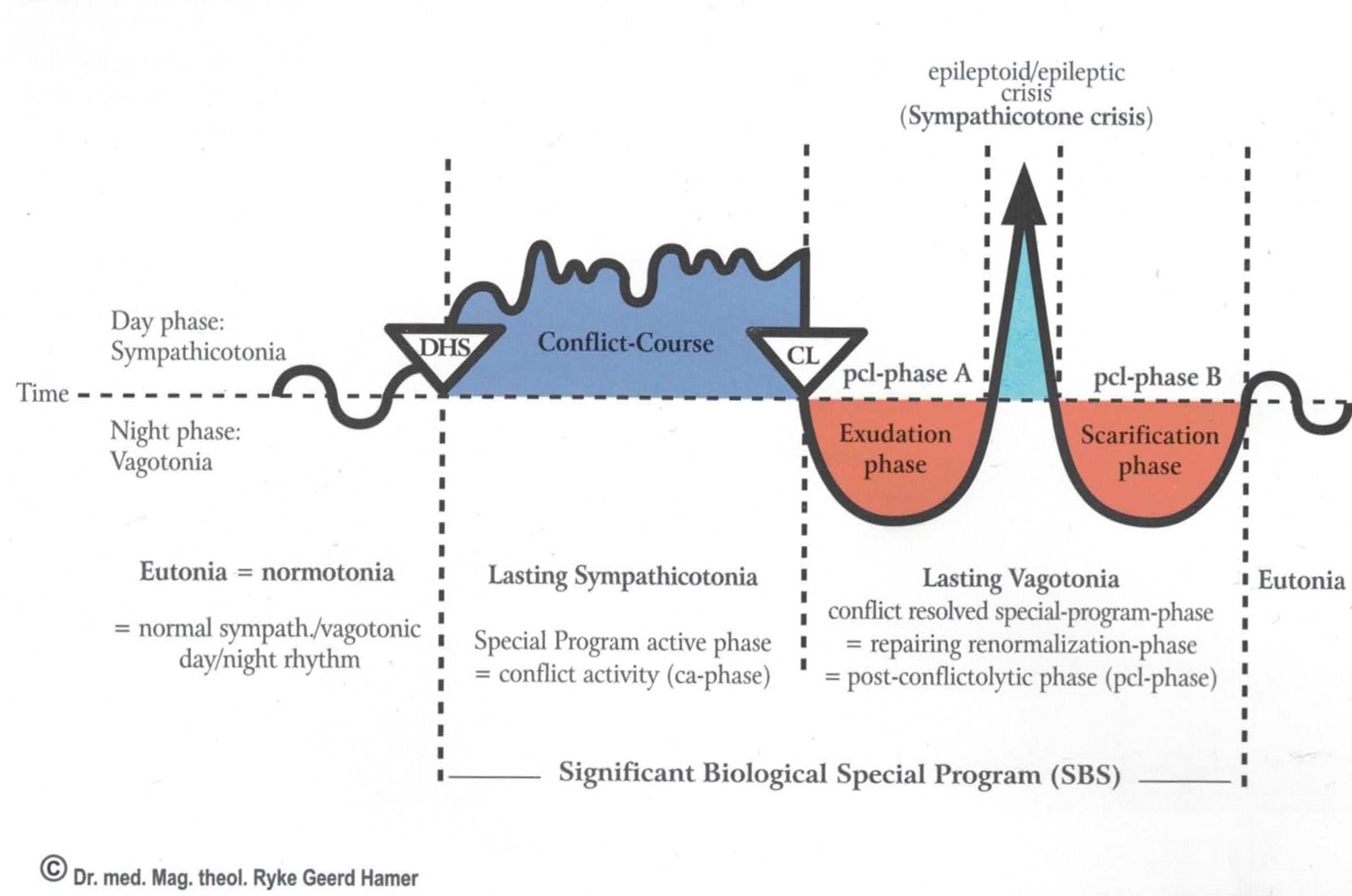
When we are shocked (DHS, or Dirk Hamer Syndrome), our nervous system goes from the normal day/night rhythm (normotonia) into the active phase. In this phase, we are sympathetic-dominant (lasting sympathicotonia), often with cold hands and feet, loss of appetite, sleep disturbances, and a feeling of isolation. In addition, there is a separate response to each type of shock. For example, in the case of a significant death fright, the lungs will respond by growing extra alveolar cells to increase the intake of oxygen, our primary requirement for life. In our current vocabulary, we call this “lung cancer.”
If the shock is resolved (CL, or conflict-lysis), our nervous system switches into the healing phase (pcl, or post-conflictolysis). In this phase, we are parasympathic-dominant (lasting vagotonia). In the first part of healing (pcl-A vagotonia), water is retained to assist in restoring damage incurred during the active phase. Inflammation is common, and we might also feel fatigue and increased appetite. Along with these general symptoms, the specific response to the shock will also change. In our lung example, the alveolar growth will stop and either encapsulate or break down, with the help of tubercular bacteria if they are present.
When enough repair has taken place, we enter a healing crisis (EC, or epileptoid crisis). This is identical to the homeopathic principle of a return of symptoms, where we experience the original symptoms of the active phase for a brief period of time, usually seconds to hours, as the nervous system undergoes a sympathetic spike. Alternatively, symptoms can become chronic (referred to as “hanging healing”). This is when the subject either relapses into the shock or has psychological reactions to the healing symptoms.
Following the epicrisis, we enter the final phase of healing (pcl-B, or scarification), in which the tissues return to stronger functionality. From here, we can move forward into our normal rhythm, better prepared to handle life’s inevitable shocks.
Without resolution, a person usually downgrades the shock and lives with it (“hanging active”). Or, in extreme cases, the subject can die from the excessive sympathetic stress, resulting in the cachexia that we sometimes observe in cancer patients. GNM explains this is the consequence of the sympathetic shutdown of the digestive and sleep functions rather than the direct result of the alveolar growth.
When a patient presents in the shock phase, the most important action is to help them identify and resolve the shock. This is not always easy or even possible. Then, to facilitate resolution, we need to focus on what they are thinking and feeling in the moment when their symptoms are better and worse, to identify the specific triggers. The symptoms themselves guide us to the related type of shock. Supportive treatments, naturopathic and allopathic, are used in parallel with common sense.
On the other hand, when the patient is in the healing phase, we help them understand that their body is actually getting better despite the unpleasant symptoms, and we guide them through the repair process with rest, diet, supplements, and any modality that doesn’t interfere with the healing process unless necessary.
Law Three
Law Three explains how tissues and organs respond to shocks, depending on the location of their neural relays in the brain.
To simplify, there are 2 types of responses mediated by the brain. The first originates in the brain stem and cerebellum (“old brain”). The second comes from the cortex and medulla (“new brain”). Different tissues have opposite ways of responding to shocks, depending on whether they are governed by the old or new brain.
In the old-brain pattern, cell growth is initiated in the active stress phase, and it arrests in the repair phase. The excess tissue either encapsulates or is degraded by the appropriate organisms.
The new-brain pattern is exactly opposite of the old-brain pattern: cells are lost by necrosis in the active phase and regrow in the repair phase. Examples of each of these patterns will be demonstrated in the patient cases. There can also be functional loss/repair mediated by the new brain, which will not be addressed here. Examples would be diabetes and multiple sclerosis.
Law Four
Law Four explains the role of microorganisms in the healing phase, either to break down excess tissue in the old-brain pattern or to help with tissue regeneration in the new-brain pattern.
Law Five
Law Five recapitulates the overall observation that conditions we think of as “diseases” are actually attempts by the body to assist us with specific, purposeful actions/mechanisms in response to primitive perceived survival threats.
Case Studies
Case Study 1
An 81-year-old gentleman (PL) presented in November 2019 with a documented melanoma, 1 cm in diameter, on his left cheek (Figure 2). He wanted to use GNM and naturopathic medicine as an alternative to surgery.
Figure 2. Case 1: Pre-Treatment
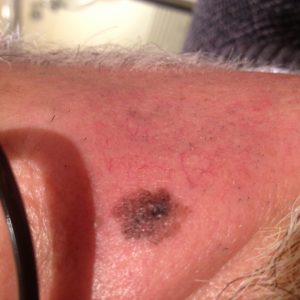
GNM explains melanoma as a protective mechanism to a perceived attack, physical or verbal, that includes an aspect of “dirtiness.” In this case, the patient recounted an issue that fit this description, and PL was coached to resolve the situation. He was also counseled to remember that his body was trying to help him, versus referring to the lesion as a dangerous cancer, as the latter could retrigger a sense of attack and stimulate further growth. PL responded well to the counsel, partly because he was too preoccupied with a huge retirement project to be obsessing about the lesion. It helps significantly when patients have a higher purpose than their illness.
In GNM, metastasis is seen as the result of a new shock, rather than cancer cells traveling from one location to another. This was explained to alleviate a common fear.
Over the next 18 months, the lesion gradually faded. Then, with the application of cannabis oil, it almost completely receded by April 2021 (Figure 3). PL was delighted with the results and is currently free of worry about recurrence, as the GNM perspective makes sense to him.
Figure 3. Case 1: Post-Treatment
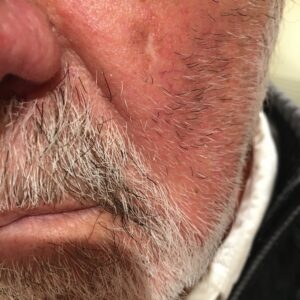
*Note: Another patient has been using GNM for a stable melanoma since October 2019, and thus far has avoided amputation of her large toe.
Case Study 2
A 51 year-old woman (DW) presented in 2006 with a lung cancer, for which the removal of one-third of her lung was recommended.
As mentioned, what we know as lung cancer is an old-brain response to a death fright, which can be on behalf of oneself (multiple small lesions) or close people (1-3 single nodules). In DW’s case, it was a single nodule that related to the death of her mother 3 years prior. The timing indicated that the nodule was encapsulated, as this type of tumor stops growing when the feared death occurs. Confirmation was that the nodule was found on a routine X-ray. There were no symptoms.
DW was taught basic GNM principles to determine whether she wanted to apply them. The explanation made sense to her and she opted to postpone the surgery, with regular scans to ensure the nodule’s continued stability. In her single visit to the clinic, she was found to be quite healthy and declined further naturopathic care.
Over the years, DW has been back at work and happily engaged in her life. The nodule remains stable in a functioning part of her lung.
Case Study 3
In 2003, a 40-year-old woman (JE) presented with a recent diagnosis of ovarian cancer and a prognosis of death in 3 months without standard treatment. In GNM, this condition is understood as a new-brain response to a death shock, such as losing a loved one unexpectedly. The active phase presents as necrosis of the ovary, which repairs itself when the patient resolves the loss. (This is an example of the new-brain pattern, as described in Law 3.) The growth continues to develop for 9 months and remains to strengthen ovarian function so that a woman can better conceive or, in the case of losing a partner, the increased hormone production makes her more attractive to a new mate.
In JE’s case, she had lost a pregnancy 8 years prior, and her subsequent inability to conceive proved to be a great distress. When she decided at age 40 to stop trying, this birthday decision was her resolution around the loss, which then allowed the ovary to begin its natural repair.
JE decided to ride out the healing phase, during which time the ovary continued to grow as expected. The growth stopped at exactly 9 months. After waiting 2 months to make sure it was stable, she had the organ surgically removed, as it was too large for her comfort level. She has been well and thriving since.
Case Study 4
In 2012, a 43-year-old man (BT) presented with cancer in his pubic bone. It had lysed half the pubis and was creating pain that required morphine and the use of a cane. His status was considered palliative, with 3 months to live.
GNM understands bone cancer as a response to a severe self-devaluation, in this case sexual. In the active phase, there is an asymptomatic lysis, which repairs with pain and inflammation as the bone fills in, assuming the shock is resolved.
In BT’s case, we knew the lesion was healing because of the pain. When this was explained to BT, his pain (which was aggravated by fear) decreased. Within 3 weeks, he was able to go off the morphine and stop using his cane. Within a few months, the bone healed and he was able to return to normal life. We check on him every few years, and continue to find him well with no recurrences.
Conclusion
These cases demonstrate how interested patients can use German New Medicine to work with their cancer diagnoses, sometimes with extraordinary results. Over the years, we have accumulated screening questions to determine the type of patient who is likely to achieve success applying GNM principles. This excludes intensely fearful people who are desperately seeking treatment, because fear and panic aggravate every situation.
GNM is useful for many other conditions as well: digestive complaints, joint pain, neurological disorders, Lyme disease, chronic infections, skin rashes, kidney disorders, heart disease, asthma, diabetes, and mental illness. It allows us to better target treatments by being aware of how the body is attempting to help a person deal with a shock, and without interfering when realistically possible. To recapitulate, we are either assisting the resolution of an active issue and/or helping a patient understand and ride out the symptoms of the healing phase.
In essence, GNM can be a foundation for guiding the use of many mind-body and physical therapies as a perfect complement to the principles of naturopathic medicine.
Resources
Note: It takes years to learn German New Medicine in depth and requires mentoring with an experienced coach. There are many resources internationally; I have found the following ones especially useful.
Books
- Eybl, Bjorn. The Psychic Roots of Disease. USA: Thirty-Three & 1/3 Publishing; 2018. Great desk reference. Available through Amazon.
- Hamer, Dr med. Ryke Geerd. Summary of the New Medicine. 3rd Edition. Spain: AMICI DI DIRK, Spain; 2000. The original thesis of Dr Hamer. Unfortunately out of print.
- Hamer, Dr med. Ryke Geerd; Scientific Chart of Germanic New Medicine. Spain: AMICI DI DIRK; 2007. An itemized list of conditions, brain levels, and shocks. Available at: www.gnmonlineseminars.com.
- Willow, Katherine ND. German New Medicine, Experiences in Practice; Ottawa, Canada: Amazon Publishing; 2019.
Websites & Courses
- www.newmedicine.ca and www.gnmonlineseminars.com. Both websites are of an excellent teacher and practitioner, Ilsedora Laker. She studied first-hand with Dr Hamer.
- www.andilockemears.com. Beginning and practitioner courses. A good place to start.
- www.learninggnm.com. This is the most complete website covering GNM. The index is used as a reference by many GNM practitioners.
- www.usagnm.com. This website has introductory articles, videos, and a summit available for purchase.
As with any new paradigm, there is fierce controversy around GNM. It will take time and research for this counterintuitive material to be widely accepted and integrated.
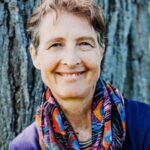
Katherine Willow, ND is a 4th-generation naturopathic doctor who graduated from NCNM in 1983. She founded and now directs Carp Ridge EcoWellness Centre in rural Ottawa, Canada, where patients can retreat for healing stays in an organic bed & breakfast on 190 acres of wilderness. They receive programs that integrate GNM, naturopathic medicine, emotional healing, energy work, and spirituality. Colleagues are welcome to visit for lively discussions on the future of naturopathic medicine! Website: www.ecowellness.com

